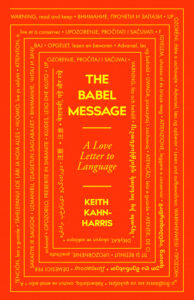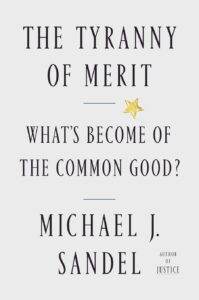TRADITION’s 2022 Book Endorsements

 TRADITION continues its yearly tradition of turning to our esteemed editorial board for endorsements for summer reading. For many, that phrase conjures images of beachside pulp fiction. Some may be amused to think of a seaside read with the 20+ hefty tomes our team chose – but that’s what you get when you turn to our editorial board for their reading picks of works of Torah, Madda, Torah uMadda, or enlightening literature that they would wish to draw to the attention of our readership. Some of the picks are almost Purimshpiel parodies of what you might have guessed would appear on a TRADITION list, others are quite surprising, all would be worthy of your attention. What follows is our first installment; an additional round was published here along with the winner of our contest to predict our picks.
TRADITION continues its yearly tradition of turning to our esteemed editorial board for endorsements for summer reading. For many, that phrase conjures images of beachside pulp fiction. Some may be amused to think of a seaside read with the 20+ hefty tomes our team chose – but that’s what you get when you turn to our editorial board for their reading picks of works of Torah, Madda, Torah uMadda, or enlightening literature that they would wish to draw to the attention of our readership. Some of the picks are almost Purimshpiel parodies of what you might have guessed would appear on a TRADITION list, others are quite surprising, all would be worthy of your attention. What follows is our first installment; an additional round was published here along with the winner of our contest to predict our picks.
Jeffrey Saks, Editor
Be-Shuvekha le-Tziyyon: Sihot ha-Rav Yehuda Amital veha-Rav Aharon Lichtenstein le-Yom ha-Atzmaut ule-Yom Yerushalayim (Yediot Sefarim)
Shlomo Zuckier
Rav Yehuda Amital and Rav Aharon Lichtenstein, both of saintly memory, the two Rashei Yeshiva of Yeshivat Har Etzion over its first forty years of existence, had the distinction of being deeply committed Religious Zionists, and at the same time developing a hashkafa rich with nuance and moderation. In a striking manner, they arrived at that philosophical disposition in opposite ways, with R. Lichtenstein holding to a consistent position that responded somewhat as the facts on the ground and community shifted, while R. Amital moved from one relative extreme to another, transitioning from a far-right Gush Emunim position to a far-left (at least for the Dati Leumi community) stance supporting the peace process and and joining Shimon Peres’ government as a cabinet minister in the mid-1990s.
More generally, both inhabited a complex worldview steeped in halakhic knowledge and ethical commitments that was engaged with the world but avoided getting hastily caught up in passing trends. Their fervent commitment to Zionism was based both on serious engagement with the Zionist writings of Rav Kook and Rav Soloveitchik, respectively, and also on their personal journeys as individuals who moved to Israel and contributed significantly to building the country and especially its Dati Leumi community, not least through their developing Yeshivat Har Etzion as an early and leading yeshivat hesder.
This just-released Hebrew volume features their Yom HaAtzmaut and Yom Yerushalayim addresses over several decades, contexts where they would reflect on their visions of Religious Zionism, both in the abstract and as it related to then current events in Israel. I have not yet had a chance to read this entire volume (it’s my own summer reading!), but I had the great privilege of being present at several of these addresses in person and of reading several others when first released online. Many of these lectures are now collected into a single volume, a must-read for anyone who wishes to appreciate the full breadth and depth of their approaches to Religious Zionism.
This alternative to an unreflective form of Religious Zionism detached from ethical concerns is more important now than ever, as these leading Rabbanim of Religious Zionism embrace nuance and ethics without sacrificing serious commitment and love of Torat, Eretz, and Am Yisrael.
Leon Kass and Hannah Mandelbaum, Reading Ruth: Birth, Redemption and the Way of Israel (Paul Dry Books)
Erica Brown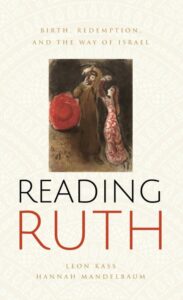
One has the distinct sense that recommending a short, accessible book increases the chances that it will actually be purchased, although word count and style alone are hardly reasons to buy a book, much less read it. But in this instance, Leon Kass and Hannah Mandelbaum’s Reading Ruth is worthwhile on every account. Kass, the prolific author, Addie Clark Harding Professor Emeritus in the College and the Committee on Social Thought at the University of Chicago and the Hertog Fellow at the American Enterprise Institute, wrote this study of Ruth with his granddaughter Hannah Mandelbaum after the death of his wife, Amy Apfel Kass, to whom the book is dedicated. Kass and his wife had, twenty years earlier, made some textual discoveries in their study of Ruth that he wished to recover after her death. Through the act of study, one senses that he and his granddaughter not only honored her memory but also held on to this woman who played such an outsized role in their lives, much the way that Ruth held onto Naomi and would not let her go.
Reading Ruth not only summarizes the Biblical book’s chapters, it also walks us through linguistic conundrums and strange turns in the narration. They describe their process in the book’s introduction: “We read slowly; indeed very slowly. We think every word matters. We attend to linguistic clues, echoes, and juxtapositions. Equally important, we attend to silences and to the things that are not said. Most important, we try to image ourselves present on the scene, inhabiting in sequence the persons of the drama, speaking their speeches, hearing the others speak, imagining the unspoken reactions to the things said.”
They also, at times, place verses within the larger context of the Hebrew Bible. As an example, in their discussion of Ruth’s approach to the threshing floor in chapter three, they compare the language to that used in Genesis (19:30-38): “The description of Ruth’s arrival, as usually translated, seems innocent enough. She comes softly, in secret, uncovers his feet, and lays herself down in that place. Still, there are small echoes of less innocent episodes. The word translated softly, lat, is used only five more times in the Bible, none of them innocent. Moreover, the verbs, ‘she came… she laid down (vatavo… vatishkav)’ are identical to the verbs used for Lot’s elder daughter: ‘and she came (vatavo), the first-born, and she laid down (vatishkav) with her father’ (Genesis 19:33). One might even suspect a near pun, of ‘lat’ and Lot.”
Word plays and textual oddities catch their attention, and they sprinkle traditional commentaries here and there, with notes at the back for further reference. Readers come away with nuggets of wisdom and an enhanced appreciation, not only for this ancient book but also for the way it brought together two people in shared grief then and now.
Keith Kahn-Harris, The Babel Message: A Love Letter to Language (Icon Books)
Jeffrey Saks, Editor
Without a doubt Keith Kahn-Harris’ recent The Babel Message is the most quirky, engaging, and enjoyable book I have read in a long time. A self-proclaimed “love letter to language” it will be enjoyed by readers of TRADITION who are excited by and invested in textual exegesis. Taking a Kinder Egg warning label as his “sacred scroll,” Kahn-Harris leads his readers on a nearly 300-page analysis of a curious text. Having raised four children, my house, where it was a Shabbat-treat of choice, is littered with the detritus of this confection, a foil-wrapped chocolate shell holding a small tchotchke. (It’s not particularly good candy nor a fun toy, but the combination is a winner.) The small interlocking toy pieces, which rarely hold their own until havdala, pose a choking hazard, and the E.U. requires the following message to appear inside the package in every language in use by member nations: “WARNING, read and keep: Toy not suitable for children under 3 years. Small parts might be swallowed or inhaled.” In the standard egg, this is printed in 37 different languages in 8 scripts. (The litigious US has a different solution: the product is simply illegal.)
Using the “Message” as a lens to focus our attention of the whimsies, vagaries, and complexities of language and translation is a surprisingly clever technique. Along the way the book offers up many worthwhile insights about that which makes humanity near-divine (see Onkelos and Rashi, Gen. 2:7). “Language is never simple and so communication is never simple. Despite that, using language to try to communicate is also just what humans do. We are driven to connect with each other.”
Along the way Kahn-Harris, a British sociologist and writer, reveals some deep Jewish knowledge (Hebrew, Yiddish, and even Ladino are discussed in the book, but its subject is universal linguistics). Reading a text, be it the Bible or a banal warning label, creates a kind of symbiosis – the text shapes us, even as our interpretation expands its meaning. Who more than denizens of the beit midrash understand that confronting a text is no passive act but can and should lead to profoundly creative engagement. It was therefore delightful to read Kahn-Harris’ description of Midrash as what he calls a type of fan-fiction: “[A] form of textual interpretation that, when applied to biblical texts, both clarifies meaning and expands it in new directions…. By engaging in the midrashic process we build on and enrich the text in all its holiness…. What Midrash shows is that it is possible to love a text without being a slave to it. By playing with the text and delving into it we do it honour.” Be it the hermeneutics of candy wrappers or, lehavdil, the Word of God, spending time with The Babel Message may help you become a more mindful reader.
Mordechai Z. Cohen, Rashi, Biblical Interpretation, and Latin Learning in Medieval Europe: A New Perspective on an Exegetical Revolution (Cambridge University Press)
David Berger
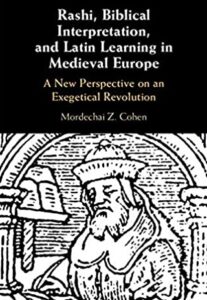 While every educated traditional Jew is aware of the importance and quality of Rashi’s commentary on the Bible, we often fail to appreciate its pioneering, innovative character. Nothing in the earlier Ashkenazic world prepares us for a work that explicitly stresses the centrality of peshat in the understanding of the text. Rashi, of course, provides an abundance of midrashic material as well, but he informs us in several places that he will not choose midrashim that do not accord—Cohen translates mityashevim literally as “settled”—with the language and order of Scripture. Midrashim incorporated by Rashi should not violate the rules of grammar and syntax nor should they stand in tension with the sequence of the presentation. (Needless to say, Cohen is well aware of ein mukdam u-me’uhar and various other examples that complicate this discourse.)
While every educated traditional Jew is aware of the importance and quality of Rashi’s commentary on the Bible, we often fail to appreciate its pioneering, innovative character. Nothing in the earlier Ashkenazic world prepares us for a work that explicitly stresses the centrality of peshat in the understanding of the text. Rashi, of course, provides an abundance of midrashic material as well, but he informs us in several places that he will not choose midrashim that do not accord—Cohen translates mityashevim literally as “settled”—with the language and order of Scripture. Midrashim incorporated by Rashi should not violate the rules of grammar and syntax nor should they stand in tension with the sequence of the presentation. (Needless to say, Cohen is well aware of ein mukdam u-me’uhar and various other examples that complicate this discourse.)
With great care, erudition, and sober judgment, the author surveys a variety of interpretive traditions that have been proposed as possible sources of Rashi’s approach. The first is the peshat-oriented exegesis to be found among the Jews in Muslim lands. With the exception of Dunash and Menahem, whom Rashi quotes explicitly, all the relevant figures wrote in Arabic, which Rashi did not read, and there is no substantial indication of influence.
Cohen goes on to discuss Byzantine Jewish commentaries, including the recently discovered works of a commentator named Reuel as well as Lekah Tov and some other texts, assessing both Rashi’s familiarity with this material and its similarity or lack thereof to his project. He does not definitively rule out some connection but does not regard its impact as probable.
He notes the suggestion that Rashi may have transferred to Biblical study the careful analytical approach to the Talmud that he learned in the yeshivot of the Rhineland and applied creatively in his monumental Talmudic commentary, but he goes on to endorse Avraham Grossman’s objection that this should have produced peshat oriented biblical exegesis in the Rhineland itself.
And what of the possible influence of the Christian environment? Several scholars have affirmed the impact of “the renaissance of the twelfth century” on Jewish exegesis, arguing inter alia that its interest in literal meaning inspired Jews to seek peshat—and to use it for anti-Christian polemical purposes. And this brings us to the book’s primary hiddush. An influential Christian scholar named Bruno of Cologne (or Bruno the Carthusian), a slightly older contemporary of Rashi who headed a cathedral school sixty-six miles from Troyes, wrote a commentary on Psalms utilizing a novel methodology that Cohen sees as strikingly similar to that of Rashi. Bruno emphasized the use of grammatica and the logical order of the text and used these as criteria for selecting allegorical interpretations from the Church Fathers much as Rashi used these criteria in his choice of midrashim. Cohen argues that given the evidence that Jewish and Christian scholars in France discussed the Bible, Rashi, though he did not read Latin, could have known of Bruno’s approach and found it useful in constructing a purely Jewish commentary. Whether or not one is persuaded by the important and intriguing hiddush connecting Bruno and Rashi, this is a work of great originality and significance that should interest any student of Rashi.
Jeremiah Unterman, Justice for All: How the Jewish Bible Revolutionized Ethics (Jewish Publication Society)
Hayyim Angel
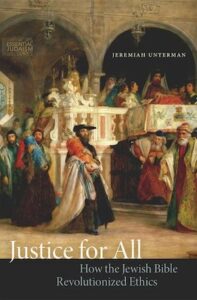 With the aggressive attacks against God, Tanakh, family values, and basic morality that have become ubiquitous in contemporary secular Western culture, I felt compelled recently to reread Jeremiah Unterman’s excellent book, Justice for All. Unterman presents a thorough and accessible summary of the scholarly research of the past century, revealing the remarkable moral revolution of the Torah within its ancient setting.
With the aggressive attacks against God, Tanakh, family values, and basic morality that have become ubiquitous in contemporary secular Western culture, I felt compelled recently to reread Jeremiah Unterman’s excellent book, Justice for All. Unterman presents a thorough and accessible summary of the scholarly research of the past century, revealing the remarkable moral revolution of the Torah within its ancient setting.
Unterman surveys significant ancient Near Eastern texts and elucidates their underlying values. He then carefully compares and contrasts biblical values with these texts, demonstrating the vast moral improvement the Torah in every area. The Torah’s belief in one just God above nature lies at the root of its groundbreaking religious program. The respective creation and flood narratives of Mesopotamia and the Torah highlight God’s moral imperative on humanity. God’s unprecedented revelation of the Torah to the entire nation of Israel and the commandment for parents to educate their children make the Torah’s values available to all. The Torah’s unparalleled legislation to care for the underprivileged derives from the singular relationship between God and Israel. The Torah and the prophets stress the centrality of ethics and offer a radically new conception of repentance. Finally, Tanakh’s conception of redemption goes well beyond any such notion in ancient Near Eastern literature.
Many of Unterman’s ideas are familiar to those who have read the monumental works of leading 20th century scholars such as Umberto Cassuto, Moshe Greenberg, Yehezkel Kaufmann, Jacob Milgrom, and Nahum Sarna, to name a few. As Unterman notes in his introduction, his book’s contribution lies primarily in the assemblage of sources, analysis, and presentation of core biblical values in a manner accessible to the general public.
The Torah calls on us to live exemplary lives to inspire all humanity to the core values of religious morality: “Observe them faithfully, for that will be proof of your wisdom and discernment to other peoples, who on hearing of all these laws will say, ‘Surely, that great nation is a wise and discerning people.’ For what great nation is there that has a god so close at hand as is the Lord our God whenever we call upon Him? Or what great nation has laws and rules as perfect as all this Teaching that I set before you this day?” (Deut. 4:6-8).
Justice for All is a valuable survey of the roots of the Torah’s religious revolution within its Near Eastern setting. Given the pressing need for a steady articulation of the Torah’s morality in today’s world, Unterman provides us with tools to appreciate and express the eternal contributions of the Torah.
Dara Horn, People Love Dead Jews: Reports From a Haunted Present (W.W. Norton)
Mali Brofsky
 People Love Dead Jews is a gem. I use that expression in the standard way; that is, this is a rare find of a book. It is full of important observations and conclusions, as well as being skillfully written in a style that is fascinating and engrossing. But I also choose this metaphor because of the nature of this book. If one reads it closely and examines each facet, one finds that they glow with truths and insights one had not previously considered.
People Love Dead Jews is a gem. I use that expression in the standard way; that is, this is a rare find of a book. It is full of important observations and conclusions, as well as being skillfully written in a style that is fascinating and engrossing. But I also choose this metaphor because of the nature of this book. If one reads it closely and examines each facet, one finds that they glow with truths and insights one had not previously considered.
I knew I would agree with Dara Horn’s thesis – essentially, that the world prefers its Jews to be dead, and that once dead, the world loves to appropriate the story of those symbolic Jews, and project onto them the world’s own preferred moral or cautionary tales. I grew up in a home of Holocaust refugees, and my family Shabbat and holiday table conversation persistently reminded me that everything is always fine for the Jews until it’s not, and I was provided with a litany of the lessons to learn from our ancestors (from immediate ones all the way back to Hazal) about how to navigate that reality, and the moral imperatives they passed down to us.
And yet, I found new wisdom in Horn’s analysis. Each chapter has something to offer, from the frozen Jews of Harbin, China, to the communist Jews of Soviet Russia. Her analysis of how non-Jews gaslight Jews into thinking that if we just give up a little more of our Jewishness everything will be fine, gave me a fresh insight into understanding assimilation. Her grappling with Shakespeare’s Shylock was an all too familiar reminder of how quick we are to let antisemitism off the hook in a way we never are for other social injustices. Her analysis of the myth of name-changing at Ellis Island is a testimony both to the not-so-rosy reality of the early American immigrant experience, as well as to the perennial optimism and forward thinking of Jews who historically told themselves stories of hope and belonging in order to survive, and to wager on a better future for their children.
Dara Horn leaves us with a searing question that is on the mind of many these days – how to grapple with the rise of antisemitism in America, a country we thought was different. She does not answer it, except in one beautiful passage where she describes the feeling of belonging and, in her words, “freedom not to pretend,” she experienced one Hanukka in Jerusalem. This tackles one of the ways that I personally deal with this question: the Jewish State and how and if it fits into this puzzle. She seems to find some answers and comfort through immersion in Jewish learning and classic texts and connection to all the Jews who came before and will come after, and in the timeless ethics and imperatives they offer us. That is another valuable insight offered by this rich and multi-faceted book.
Moshe Sokol, Judaism Examined: Essays on Jewish Philosophy and Ethics (Touro College Press)
Michael Shmidman, Editor Emeritus
 One of the reasons advanced by those who argue that philosophic thinking and methodology are less avidly pursued today within the traditional Jewish community is the perceived or imagined inherent difficulty of the philosophical enterprise. To illustrate that factor, David Shatz, writing in TRADITION, relates a joke about “a philosopher who loses his job in academia and goes to work for organized crime. On his first day on the job, he walks up to someone, shoves a gun in his ribs, and admonishes ‘I’m going to make you an offer that you can’t understand’.”
One of the reasons advanced by those who argue that philosophic thinking and methodology are less avidly pursued today within the traditional Jewish community is the perceived or imagined inherent difficulty of the philosophical enterprise. To illustrate that factor, David Shatz, writing in TRADITION, relates a joke about “a philosopher who loses his job in academia and goes to work for organized crime. On his first day on the job, he walks up to someone, shoves a gun in his ribs, and admonishes ‘I’m going to make you an offer that you can’t understand’.”
In Judaism Examined, a collection of eighteen essays on Jewish philosophy and ethics by distinguished scholar, rabbi, and veteran dean of the Lander College for Men, Professor Moshe Sokol, philosophic ideas and concepts are both brilliantly analyzed and lucidly clarified. Sokol’s limpid prose expertly guides the reader through the intricacies of issues ranging from human autonomy, freedom of the will, and tolerance, to Jewish approaches toward the meaning of joy, the nature of the philosophical life, responses to evil and suffering, attitudes toward pleasure, and the meaning of mitzvot; and from studies in the thought of R. Joseph B. Soloveitchik to topics in hermeneutic theory and problems in applied Jewish ethics (e.g., the allocation of scarce medical resources, the taking of human life, and environmental issues).
These essays go beyond the often-encountered emphasis upon the history of philosophy to formulations of creative and novel approaches to the aforementioned problems and active engagement with the ideas and conceptual frameworks of Jewish thinkers. The perspective utilized so skillfully by the author is that of analytic philosophy, the method in which Dr. Sokol was academically trained. The conceptual rigor and precision of the method is evident, for example, in the essay on “Attitudes Toward Pleasure in Jewish Thought: A Typological Proposal,” in which a classificatory framework is developed for analyzing attitudes toward bodily pleasure, consisting of six conceptually distinct schools of thought identified by the author — extreme asceticism, moderate asceticism, ascetic neutralism, liberal neutralism, liberalism and hedonism. The author’s analysis of these categories concludes that only four (excluding extreme asceticism and hedonism) took root in Jewish tradition.
Readers of this volume will be amply rewarded by Sokol’s characteristically rigorous exploration and compelling presentation of the rich array of topics included in the book. (Full disclosure: I served as editor of the series in which this excellent book appeared.)
Michael J. Sandel, The Tyranny of Merit: What Becomes of the Common Good (Macmillan)
Daniel Z. Feldman
It is taken as a given that one of the most admirable aspects of the American experiment is a belief in both the value of and the possibility of meritocracy; in fact, this is an integral pillar of “the American Dream.” In his book The Tyranny of Merit, Harvard’s Michael Sandel calls this very premise itself into question.
Central to his thesis is the argument that the belief that meritocracy is more just than aristocracy is a flawed premise. Clearly, aristocracy bestows upon certain individuals advantages that are unavailable to others, and thus elevates them to positions of wealth and influence for reasons that reflect no credit them nor blame on those disadvantaged. However, argues the author, it should not be granted that meritocracy is more just. The factors that allow one to succeed are not only hard work and initiative; there are many that derive from sources beyond the control of the individual, such as educational opportunities and even talent, significant components not available to those not born with them.
One could respond to this postulation by noting that there remains a crucial difference between an aristocracy and a meritocracy, even if the latter is deceptive in its putative egalitarianism. Aristocracy structures society to benefit the privileged without any corresponding gain for the common good. By contrast, a meritocratic system, even if it does not distribute its rewards with total justice, does so with some correspondence to public welfare.
Ray Dalio’s Principles for Dealing with the Changing World Order suggests that a meritocracy is both the route to the “most sustainably successful” societies and “perceived as the fairest.” Sandel disagrees, although it is possible that even the “fairest” is still at too great a distance from truly fair. The remainder of The Tyranny of Merit is devoted to suggestions as how to bridge that gap (R. Shalom Carmy critiqued some of these approaches, while admiring their purpose, last year.)
These issues resonate especially powerfully within the American Orthodox community, for reasons of justice and social responsibility, but also because of the foundational issues of the mandate of Talmud Torah. The question of the effectiveness of the yeshiva system in addressing the spiritual and educational needs of all of its students has long been a vexing one, especially regarding who has access to Jewish education. The Talmud’s statement that “Yehoshua ben Gamla ensured that Torah would not be forgotten among the Jewish people” is understood by Maharsha to be an exaggeration; seemingly he helped only the orphans who needed the education otherwise unavailable to them. It is possible, though, to understand the statement more literally: the very viability of a nation defined by divine wisdom is contingent on wide access to that wisdom.
In contemporary America, there are factors that not only diminish access but fundamentally alter the message of the yeshiva system itself. The economic pressures create a reality in which those who earn even an average salary, including those who serve in occupations of vital importance to the Jewish community, receive the implicit message that they are of less value to that community, with accompanying insinuations of deficient social responsibility. This reality inverts the moral message of a Torah education, and inflicts a poverty far more consequential than the lack of funds.
Margaret MacMillan, Paris 1919: Six Months That Changed the World (Random House)
Menachem Genack
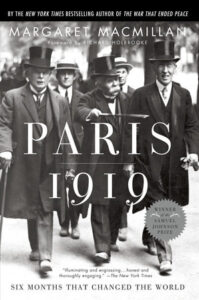 As the most devastating event in human history, World War II tends to eclipse the other tragedies of the 20th century. But it is useful to broaden our scope and understand how the previous global conflict, World War I, led to the hostilities of 1939-1945. Margaret MacMillan has produced a riveting account of how the Treaty of Versailles ensured that “the war to end all wars” was only a prelude to an even worse conflict only twenty years later.
As the most devastating event in human history, World War II tends to eclipse the other tragedies of the 20th century. But it is useful to broaden our scope and understand how the previous global conflict, World War I, led to the hostilities of 1939-1945. Margaret MacMillan has produced a riveting account of how the Treaty of Versailles ensured that “the war to end all wars” was only a prelude to an even worse conflict only twenty years later.
MacMillan’s presentation of the personal interplay between the attendees at the Paris Peace Conference (which culminated in the treaty) is colorful. In addition to the main actors—America’s Wilson, Britain’s Lloyd George, and France’s Clemenceau—MacMillan mentions a supporting but noteworthy cast of characters including the economist John Maynard Keynes (who resigned in protest of the severe peace terms) and Ho Chi Minh (who was a cook at the time). This was also the first time that great powers addressed Jewish concerns on the international stage: Chaim Weizmann attended the conference representing the Zionist Organization.
The central thesis of the book dispels the popular notion that the rise of nationalism and remilitarization of Germany was primarily motivated by the German people’s resentment of the crushing reparations that the victorious allies imposed. MacMillan notes that Germany did not wind up paying most of what it owed; in fact, she argues, it was the territorial losses that led to a decline in German pride which Hitler exploited.
MacMillan also emphasizes that the German populace remained unaware of the totality of Germany’s defeat; thus, they were blindsided by the Allies’ ability to dictate harsh terms of peace. This ignorance was due to the fact that the battles were fought on foreign soil and barely touched Germany itself. Contrast this to today’s conflict in Ukraine, where images of the devastation are broadcast throughout the world.
MacMillan also points out President Wilson’s failures at the conference: He neglected to court Senate moderates, preventing the United States from joining the League of Nations and thereby crippling the fledgling body that could have mitigated rising tensions in the 1930s. And in an ironic twist, Wilson rejected Japan’s demand to have an anti-discrimination clause in the treaty as a reward for siding with the Allies, and instead granted Japan control over the Shandong peninsula in China and some nearby islands. Japan later used these territories as a military staging ground during World War II, when it fought against the United States.
It is at once painful and instructive for the future to read about how the peacemakers squandered the opportunity to create a lasting peace after World War I, and instead paved the way for the Holocaust and general world instability that persists even today. MacMillan has offered us a fascinating addition to historical scholarship.
Thorstein Veblen, The Theory of the Leisure Class: An Economic Study of Institutions (Macmillan)
Yitzchak Blau
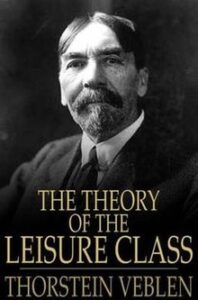 What would happen if advanced technology generated a world in which all classes of society had every one of their needs and desires met, including not just necessities but even luxuries? One might think that class distinction would become irrelevant but Thorstein Veblen, in his The Theory of the Leisure Class (1899), disagrees. According to Veblen, society would simply generate a set of new modes of leisure, irrespective of utility, that only the “haves” can afford. Leisure activities convey status and prestige more than they provide useful benefit, whereas productive labor actually bestows a mark of inferiority. Veblen coined the term “conspicuous consumption” to convey how the crucial aspect of these activities is their being noticed in order to reflect on the status of those engaged in them.
What would happen if advanced technology generated a world in which all classes of society had every one of their needs and desires met, including not just necessities but even luxuries? One might think that class distinction would become irrelevant but Thorstein Veblen, in his The Theory of the Leisure Class (1899), disagrees. According to Veblen, society would simply generate a set of new modes of leisure, irrespective of utility, that only the “haves” can afford. Leisure activities convey status and prestige more than they provide useful benefit, whereas productive labor actually bestows a mark of inferiority. Veblen coined the term “conspicuous consumption” to convey how the crucial aspect of these activities is their being noticed in order to reflect on the status of those engaged in them.
In ancient barbarian society, the victorious group in battle took the spoils of the vanquished as a sign of triumph, even if the goods were not useful to them. At some point, a similar divide occurred with the members of even one society. The upper class became conspicuous consumers of luxury items and behaviors as a mark of their prowess and prestige.
Veblen (1857—1929), an economist and sociologist, was born to a Norwegian immigrant family of hardscrabble homesteaders in the American upper Midwest. After a checkered career lecturing at the University of Chicago and elsewhere he became a founding member of the New School for Social Research, which became the center of gravity for American progressivism and allowed him to advance his critique of capitalism. Veblen identifies many markers of the noble classes in non-productive endeavors such as sports, dress, particular kinds of food and drink, having a servant staff, manners, religious rites, and higher education. Dress serves as a prime example of a visible expression which often prizes aesthetics over utility and with styles frequently changing compelling people to spend money and keep up. In terms of education, study of Greek and Latin does not clearly address societal needs (or serve some obvious vocational utility). In contrast, the rest of society practices economically productive manual labor such as agriculture and manufacturing.
This work contains import mussar for our community even as Veblen pushes his central thesis too far. The search for status often guides us in problematic directions and we lose sight of the things that truly matter. On the other hand, we should not restrict that category to humanity’s basic physical needs. Not everyone who receives a doctorate from Harvard in theoretical math or ancient languages does so primarily for the prestige involved; some truly find such study ennobling and enriching. The same applies to religious rites and other items on Veblen’s list. Let us guard ourselves from arrogance and waste even as we realize that “man does not live by bread alone.”
Rafael Medoff, The Rabbi of Buchenwald: The Life and Times of Herschel Schacter (Yeshiva University Press)
Judith Bleich
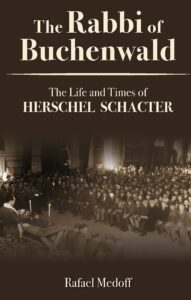 The Rabbi of Buchenwald is aptly subtitled The Life and Times of Herschel Schacter. In the course of history there are junctures at which religious, cultural and sociological changes occur rapidly. Different times call for different leaders. Most challenging is leadership during the gap between those times. Rabbi Schacter’s life straddled radically different times. Medoff portrays his talents as a leader and spokesman for a fading Yiddish-speaking, European-American generation and a nascent American-born generation that had not yet reached maturity.
The Rabbi of Buchenwald is aptly subtitled The Life and Times of Herschel Schacter. In the course of history there are junctures at which religious, cultural and sociological changes occur rapidly. Different times call for different leaders. Most challenging is leadership during the gap between those times. Rabbi Schacter’s life straddled radically different times. Medoff portrays his talents as a leader and spokesman for a fading Yiddish-speaking, European-American generation and a nascent American-born generation that had not yet reached maturity.
Those of us who knew Rabbi Schacter personally can readily appreciate the difficulty of conveying his forceful presence, the boundless energy, sparkling oratory, empathic warmth, mischievous smile, and twinkling eye. Rabbi Schacter’s career spanned decades of service beginning with his unmatched chaplaincy, followed by years at the helm of the Mosholu Jewish Center, national leadership roles in the Religious Zionist and Soviet Jewry movements, to his many accomplishments as the president of the Conference of Presidents of Major American Jewish Organizations.
Those years coincided with an era during which American Jewry grappled with major social and political crises. Incorporating thorough historical detail and a wealth of citation, Medoff’s narrative offers illuminating insights to the conflicting views of various Orthodox groups regarding public protests on behalf of Soviet Jewry. Rabbi Schacter’s success in pacifying opposing constituencies was the product of a rare ability to mediate between widely disparate interest groups. Medoff’s work is singular in its understanding of the subtle nuances and complex relationships of the often contentious Orthodox factions. I know of no contemporary observer who has depicted the interactions of Mizrachi and Agudah, the Rabbinical Council of America and Agudas ha-Rabbonim, with comparable accuracy, sensitivity, and total lack of bias.
Rabbi Schachter’s personal impact upon the lives of individuals was as significant as his role in the public arena. Highlighted in the popular imagination is his dramatic announcement in Buchenwald, “Yidden ihr seit frei.” Less well known, but of even greater import, were his subsequent undertakings on behalf of camp inmates and his ongoing assistance to survivors. Later, throughout his rabbinate in the Bronx, he played a formative role in the lives of the congregation’s youth. His influence on a number of those young congregants was life-changing. Rabbi Schacter’s dynamic engagement with youngsters did not wane as he himself aged. Among the celebrated events in his life was his participation in the historic 1956 rabbinic delegation to the USSR. In 1984 he again visited Russia and did so once more in 1989. Of that visit he remarked, “I don’t want to sound immodest, but sort of by popular demand we were asked to come back again.” Rabbi Schacter was not being immodest. Following his 1984 visit , my husband and I traveled to Russia. I vividly recall a group of refuseniks who asked whether we knew Rabbi Herschel Schacter. He had just been in Russia, they told us, and his study sessions, stories and discourses, were simply unforgettable. They had listened for hours, fascinated and mesmerized. May Rabbi Schacter’s life, so masterfully captured in the pages of this consummate biography, serve to inspire future generations.
This is the first of two installments in this feature. Click here for the remaining endorsements and learn the identity of our contest winner. Peruse previous lists of TRADITION’s Summer Book Endorsements for 2020 & 2021.


